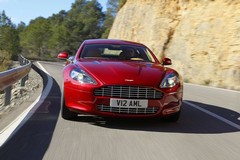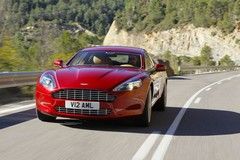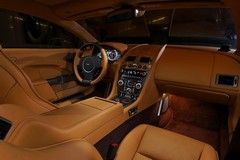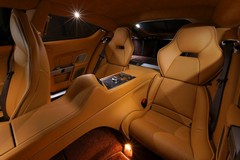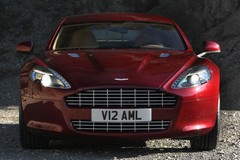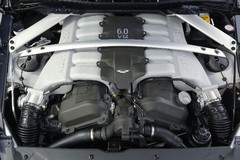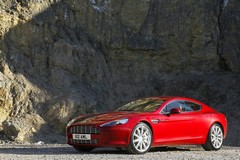Aston Martin Rapide - First Drive
Adam Towler samples the new 'four-seater sports car' from Aston

The premise of the Rapide is simple: it’s a four-seater sports car, says Aston Martin. Not a limo. Absolutely not a limo. But since the Rapide concept was shown in 2006 there are new rivals in this exalted niche, from Porsche and Maserati among others, as well as considerably tougher market conditions. Has it been worth the wait?
The Rapide, not surprisingly, is a car built up from parts any followers of the company will recognise. It uses Aston’s usual ‘VH architecture’ of an aluminium bonded chassis as a starting point, while in the engine room is the familiar 6.0 V12 – here in ‘hi-torque’ tune sporting 469bhp and 443lb ft. There’s the tried and trusted 6-speed ‘Touchtronic 2’ transmission from ZF, too, and you’ll certainly recognise the main centre stack and cockpit instrumentation.
The DB9 similarities don’t end there, because aesthetically it’s clearly a close relation of its coupe stable mate. I will leave it to you to debate the merits of the design and that aforementioned close relationship, but for what it’s worth, I’d say it was a car that has genuine presence ‘in the metal’: one with gorgeous angles, and also one with some uncomfortable angles. Fortunately, up close it’s the carefully honed surface treatments and delectable curves that preoccupy your mind. It’s also a big car: some five metres in length, and you can’t help but wonder at the validity of Aston’s ‘four-door sports car’ claims.
Yet the more you talk to the Rapide’s engineering team, the more you appreciate the work that has gone into this new car. And more than that, It’s the talk of overall product harmony and of clearly defined targets in the various working groups that gives the impression that someone has really gotten hold of this project by the scruff of its neck. There are improvements via modifications to the chassis; the new rear sub frame; new window sealing technology; the steering column isolator; the way the dash no longer rests against the glass but sits fractionally lower against foam (to avoid unwanted squeaks): yes, it’s hundreds of often quite small engineering changes that have achieved these advancements, and the results are very impressive. Just as the DBS, with its improved build quality, cohesiveness of control weights and dynamic resolve, put the relative rawness of the very first DB9s and V8 Vantages into perspective, so the Rapide raises that bar again for much the same reasons. It’s a sign of maturity from a company that now has a decade behind it of building ‘modern’ cars of this type, and that steadily engineered evolution really shows.
But first, we need to talk about the Rapide’s interior packaging. You get a strong feel for the rear-seat accommodation on offer as the door swings open, revealing a rather narrow aperture. Once you’ve fallen bum-first into the seat and brought your legs across, it’s clear that the Rapide is ‘cosy’ to say the least. The individual rear seats are very ‘bucket type’ in their design, and separated by a high central spar that contains HVAC and heated/cooled seat controls. I’m around six-foot two in height and head and knee room for me is marginal: I reckon I’d be happy to travel for an hour in the back of a Rapide, but not to cross whole countries. Nevertheless, I’d say a child or someone of average height should be fine, so the car should work for most (well-off) families, but not as a four-up businessman’s express like the Panamera.
The build quality seems absolutely spot on though – not a creak or rattle from these test cars with 5,000 very hard miles under their belts – and the interior, save aspects of the dash as already mentioned including the flaky old Volvo sat nav, does make you feel really special, with fine leathers and lovely bespoke detailing.
Before getting behind the wheel I travel briefly in the back and I’m immediately struck by the quality of the ride – firm, but very well damped and perfectly comfortable. It’s a positive omen, because from here on in it’s almost all good news with the Rapide. On a relaxed jaunt through city traffic or on the motorway the car is admirably refined: wind and road noise suppression are far better than I had imagined, and the ride is very well judged.
Then, when you want to enjoy your driving it moves effortlessly out of that mode and into something altogether more enthusiastic. The V12 suddenly howls, you click through the gears using the paddles and start to drive the thing, whereupon the steering – lighter than usual and easy around town – offers great precision and plenty of feedback, without the kickback of earlier VH cars. The rack has a quicker ratio to make up for the longer wheelbase, and on the very tight, twisting roads of the Spanish launch location it’s amazing how keen the Rapide is to get stuck in – especially for a 5 metre long, near two tonne monster. There’s a really nice balance to the chassis: the roads are so slippery that everything happens in almost slow motion, and you can easily feel the onset of understeer and then the rear axle start to lose grip beyond a certain point. As such, the Rapide does feel like a sports car, and as much as I might have scoffed beforehand at the thought, I do find myself forgetting the two extra seats behind me and getting lost in the driving experience.
Overall, the V12 does a decent job but not much more. It makes lots of noise when stoked and on start-up, but it doesn’t have the smoothness or layers of timbre like a Ferrari V12, and the straight-line performance is ‘very rapid’ without being ‘indecent’ (0-60mph in 5.0sec; 184mph flat out). In all honesty though, not once do I find myself wishing for anything more. On the whole, the gearbox is a good partner for it, but it doesn’t like full bore/red line up shift particularly and the slurring of gears sounds a bit naff at times. The new dual-cast Brembo brakes are just right however: plenty of retardation and a particularly nice pedal feel.
Much like Maserati managed with the Quattroporte, Aston Martin has built a 4-seat car of nearly two tonnes that really does drive ‘like a sports car’. Its peculiar blend of internal packaging, terrific thirst and price (£139,950 – ouch) place it in a very small niche, but once driven it’s hard not to be seduced by its sense of occasion, abilities and sheer polish: it’s a really fine car.
Gassing Station | General Gassing | Top of Page | What's New | My Stuff

